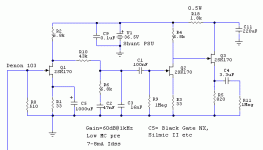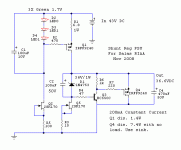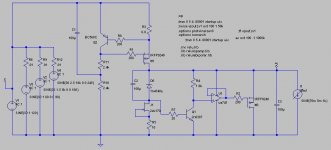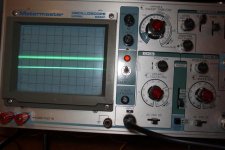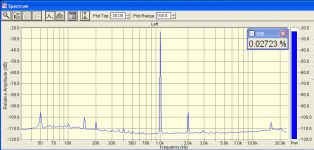Hey thank you so much Salas - super fast respense and very helpful indeed 
I will build that version using some tagboard I have and hope that works OK. Now I need to read about matching my JFETS and I can begin
Nicoch46: I've only used the 103R through a (totally) rebuilt Quad 34 phono stage/pre-amp, and later a Creek OBH-15 phono stage. In both it sounded VERY organic and natural. I was also using a Goldring G1042 (which many seem to like) but to me it sounds a little harsh with a lack of tonal colour - like HERE is the music, you MUST listen. Rather than a more subtle approach like the 103R. Still this may just be because of the cheap phono stages?
The 103R is great at giving you the atmosphere of the music too, and it doesn't seem bothered by surface noise - it's a very good tracker too I think. End of disc sounds in control, unlike my G1042 sometimes. Hope this helps
I actually have a SKA GB150D amp which I need to get a case for, then it will be my no.1 amp, and I'll use it with the KingRex Pre and Salas phono stage.
I will build that version using some tagboard I have and hope that works OK. Now I need to read about matching my JFETS and I can begin

Nicoch46: I've only used the 103R through a (totally) rebuilt Quad 34 phono stage/pre-amp, and later a Creek OBH-15 phono stage. In both it sounded VERY organic and natural. I was also using a Goldring G1042 (which many seem to like) but to me it sounds a little harsh with a lack of tonal colour - like HERE is the music, you MUST listen. Rather than a more subtle approach like the 103R. Still this may just be because of the cheap phono stages?
The 103R is great at giving you the atmosphere of the music too, and it doesn't seem bothered by surface noise - it's a very good tracker too I think. End of disc sounds in control, unlike my G1042 sometimes. Hope this helps
I actually have a SKA GB150D amp which I need to get a case for, then it will be my no.1 amp, and I'll use it with the KingRex Pre and Salas phono stage.
The 103 and its variants need lossy headshell coupling and non rigid arms as well as 510R-1k loading. They were designed for old EMT studio stuff with lossy arms and removable headshell. Use them with resilient washers between headshell and cart body, and they will sing.
ikoflexer said:Ricardo, that's great. I yet have to play with the loading resistor (I use no cap). The smaller size resistors will be replaced once I receive my order of evanohm wire and roll my own non-inductive resistors
I'm also waiting for some russian PIOs and for this
http://cgi.ebay.ca/FT-3-Hi-END-Teflon-Capacitors-0-1uF-600V-5-NEW-2-pcs_W0QQitemZ390028694477QQcmdZViewItemQQptZBI_Electronic_Components?hash=item390028694477&_trksid=p3286.c0.m14&_trkparms=72%3A1215|66%3A2|65%3A12|39%3A1|240%3A1318
Hi ikoflexer
How did the deal end up ?
I would like to try these caps also and this dealer is still operating.
Did you like the sound of those caps ?
I have been trying several cart loading resistors and the best seems to be 1k82r...
Regards
Ricardo
My Denon DL160 matched 40-44dB version got a full phono board rebuild including Shinkoh 1k cart load and AN tantalum series RIAA resistors. Eliminated the input coax due to very short proximity to input RCAs, used extra short solid silver wire there. The Ruskie FT3 is used for interstage. Excellently neutral and coherent without bypass, so to answer Ikoflexer's earlier query too. I also added the buffer stage. It only helps with distortion and drive, could not hear any negative effect, only more ease and tranquility.
Used BHC 10mF Slit Foil PSU filter cap and BGN 680uF in the shunt's output too. The Denon DL160 on the Mission 774 and Walker CJ58 sound like a million dollars with this carefully hardwired with solid copper buss bar, silver solder, and minimum point to point joints phono.
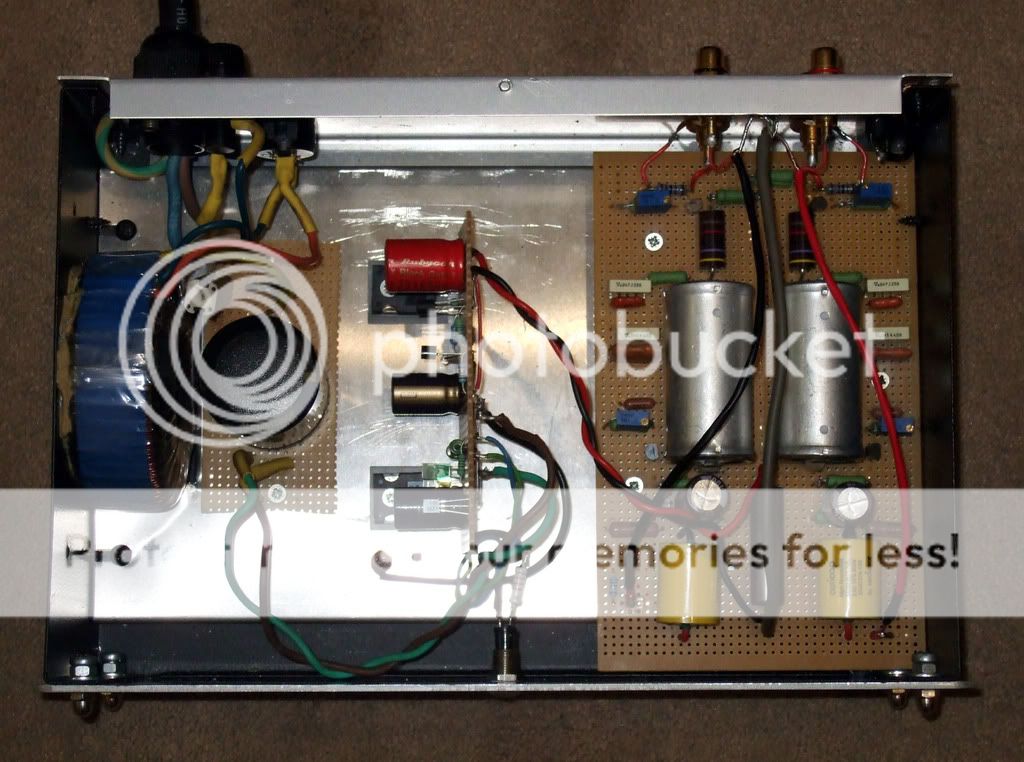
Used BHC 10mF Slit Foil PSU filter cap and BGN 680uF in the shunt's output too. The Denon DL160 on the Mission 774 and Walker CJ58 sound like a million dollars with this carefully hardwired with solid copper buss bar, silver solder, and minimum point to point joints phono.

I hope that you got the info you wanted for FT3 with my rebuild post. Also as you see, different phono stages can tune with different Rload. You settled for 39k with the Meridian 101 and now you went down to 1k82 for instance. Things are open as long as we safely stay 10X the cart's generator resistance and upwards for Rload. Even the tonearm cabling or the quality of Rload can lead to different preferences. Never take recommendations from other set ups for granted.
Wow that looks like a work of art Salas - wish I could build one that fast!
I don't suppose you have any pictures of the underside to help us 'technologically challanged' types?... (aka myself haha )
)
Regarding your earlier post, yes I've heard that lossy arms are the best for the 103 and variants. However I have to use mine in a highly modified Rega RB250, but even there it seems happy and sounds great. The common mod with the RB250/103(R) is to add mass at the headshell - I believe 8gm (or 20p!) is meant to do the job well, though I've yet to try this as my counterweight isn't heavy enough to cope with that extra mass. Ive had the paint removed, all the wiring replaced, and bearings re-aligned (by the fantastic Johnnie at Audio Origami), and a michell counterweight installed. I'm sure another arm would work better, but for now it seems to do the job well enough.
Next... to get my Garrard 301 re-assembled.... so many projects... so little time haha!
- john
p.s. whats the latest preferred shunt PSU circuit please?
I don't suppose you have any pictures of the underside to help us 'technologically challanged' types?... (aka myself haha
Regarding your earlier post, yes I've heard that lossy arms are the best for the 103 and variants. However I have to use mine in a highly modified Rega RB250, but even there it seems happy and sounds great. The common mod with the RB250/103(R) is to add mass at the headshell - I believe 8gm (or 20p!) is meant to do the job well, though I've yet to try this as my counterweight isn't heavy enough to cope with that extra mass. Ive had the paint removed, all the wiring replaced, and bearings re-aligned (by the fantastic Johnnie at Audio Origami), and a michell counterweight installed. I'm sure another arm would work better, but for now it seems to do the job well enough.
Next... to get my Garrard 301 re-assembled.... so many projects... so little time haha!
- john
p.s. whats the latest preferred shunt PSU circuit please?
Hi Salas
Yes, your answer was determinant... I will order some FT3 soon.
Now I understand that rload is system dependent. It is affected by the choice of C3, VTA, cart down preassure, cabling... I believe there is a sweet spot somewhere.... I changed from 39k to 680r and the sound was muffled.. now with 1k82 it is singing... but I know it can be better...must keep searching.
BTW Where did you get the 680u BGNx ?
Ricardo
Yes, your answer was determinant... I will order some FT3 soon.
Now I understand that rload is system dependent. It is affected by the choice of C3, VTA, cart down preassure, cabling... I believe there is a sweet spot somewhere.... I changed from 39k to 680r and the sound was muffled.. now with 1k82 it is singing... but I know it can be better...must keep searching.
BTW Where did you get the 680u BGNx ?
Ricardo
Johnm:
I recommend you to try resilient washers between 103R and Rega headshell. You would have to slightly readjust the VTA non the less.
Unfortunately I haven't got this underside photoed, but if you look on early pages you can see some pictures of the technique when the Riaa was in testing phase with batteries. In general, a U shaped thick copper peripheral buss bar is used, and the input grounds are soldered at its respective open ends. The output RCA grounds are tied together and with one thick wire they go at U bottom. The output coaxial cables are shield one end soldered only on the common output RCAs GND. The whole thing progresses symmetrically from open ends to end of U, stage by stage, grounding to the buss. Valve construction technique in short. Silver content solder is used. I always listen to better analysis, fluidity, calmness and stage VS any PCB, if the p2p is careful. Less soldering points, no thin traces, direct paths, can't lose. Not for the fainthearted though, and it takes practice. I thank my valve background for that. Big plus is rapid prototyping also, last but not least. The recommended 36.5V shunt has been pointed out and posted many times, but since you seem a bit lost as a late comer, here it is 4U again.
I recommend you to try resilient washers between 103R and Rega headshell. You would have to slightly readjust the VTA non the less.
Unfortunately I haven't got this underside photoed, but if you look on early pages you can see some pictures of the technique when the Riaa was in testing phase with batteries. In general, a U shaped thick copper peripheral buss bar is used, and the input grounds are soldered at its respective open ends. The output RCA grounds are tied together and with one thick wire they go at U bottom. The output coaxial cables are shield one end soldered only on the common output RCAs GND. The whole thing progresses symmetrically from open ends to end of U, stage by stage, grounding to the buss. Valve construction technique in short. Silver content solder is used. I always listen to better analysis, fluidity, calmness and stage VS any PCB, if the p2p is careful. Less soldering points, no thin traces, direct paths, can't lose. Not for the fainthearted though, and it takes practice. I thank my valve background for that. Big plus is rapid prototyping also, last but not least. The recommended 36.5V shunt has been pointed out and posted many times, but since you seem a bit lost as a late comer, here it is 4U again.
Attachments
RCruz said:Hi Salas
Yes, your answer was determinant... I will order some FT3 soon.
Now I understand that rload is system dependent. It is affected by the choice of C3, VTA, cart down preassure, cabling... I believe there is a sweet spot somewhere.... I changed from 39k to 680r and the sound was muffled.. now with 1k82 it is singing... but I know it can be better...must keep searching.
BTW Where did you get the 680u BGNx ?
Ricardo
You will again search for best Rload when you change parts quality most likely.
I cannibalized some other reg for the BG.
 I don't think its easy to find any more.
I don't think its easy to find any more. 
Thanks for that Salas - I did search back through the forums, but backwards.... of course I was on the page BEFORE the schematic when you replied haha! That looks great, and I seem to have many of the parts already - the audio Gods must be on my side today 
I'll get some perf board and start building next weekend fingers crossed.
Thanks again for the help.
- John
I'll get some perf board and start building next weekend fingers crossed.
Thanks again for the help.
- John
For what it's worth, attached is the regulator schematic that has shown both in simulation, and in practice, the best regulation. I have tried all of the different variations in this thread, and have tried the sulzer, and jung regulator as well.
This attached schematic I have built a few hours ago, and the oscilloscope trace on the most sensitive setting, 5mV/div, showed a straight line, just a tiny bit thicker than when the scope is set on GND. This is as close I've got to DC, ever. It seems stable. There are more details about the things I've experimented with, such as different opamps, different driver instead of the darlington, but this configuration showed here was best. As far as the sound goes... that I don't know. Somebody else with more experienced ears should test it.
This attached schematic I have built a few hours ago, and the oscilloscope trace on the most sensitive setting, 5mV/div, showed a straight line, just a tiny bit thicker than when the scope is set on GND. This is as close I've got to DC, ever. It seems stable. There are more details about the things I've experimented with, such as different opamps, different driver instead of the darlington, but this configuration showed here was best. As far as the sound goes... that I don't know. Somebody else with more experienced ears should test it.
Attachments
Looks OK. But under some threshold, the scope will just show nice lines and it is difficult to evaluate small gains.
You will need FFT. Here is the FFT of the pictured phono, fed with DL160 nominal 1.6mV 1kHz. The 50Hz peak is the total hum. Good for such a small box with an non shielded transformer inside, and just p2p. That -107dB 100Hz edge might be the ripple residual or just random noise floor grass. Also that 16kHz -105dB peak might be interference from some TV scan frequency.
You will need FFT. Here is the FFT of the pictured phono, fed with DL160 nominal 1.6mV 1kHz. The 50Hz peak is the total hum. Good for such a small box with an non shielded transformer inside, and just p2p. That -107dB 100Hz edge might be the ripple residual or just random noise floor grass. Also that 16kHz -105dB peak might be interference from some TV scan frequency.
Attachments
salas said:
You will again search for best Rload when you change parts quality most likely.But you will be in the ballpark after this search phase.
I cannibalized some other reg for the BG.I don't think its easy to find any more.

Hi Salas
With the 1k82 rload, the riaa is really singing ... I will try 2k21 just to be sure but I believe I am quite near the über setting.
now I would like to bypass the output caps and you suggested 0.047u PIO.... as I do not have any left, I would like to try other caps ... I have some ERO KP 1832 3000pF and some 4700pf styroflex... Can I use these caps or should I buy some 0.047u as per your indications? (My output caps are 4.7uF mundorfs MKP).
Is there a rule for these bypasses ? Should I use 1/10 of the original value or 1/100 ?
Regards
Ricardo
PS Just ordered some 0.1u Teflon CCCP caps just like yours for the Riaa circuit.
Thank you so much for the precious help... The Riaa is starting to sound as big as my superhyper CD53.
- Home
- Source & Line
- Analogue Source
- Simplistic NJFET RIAA
